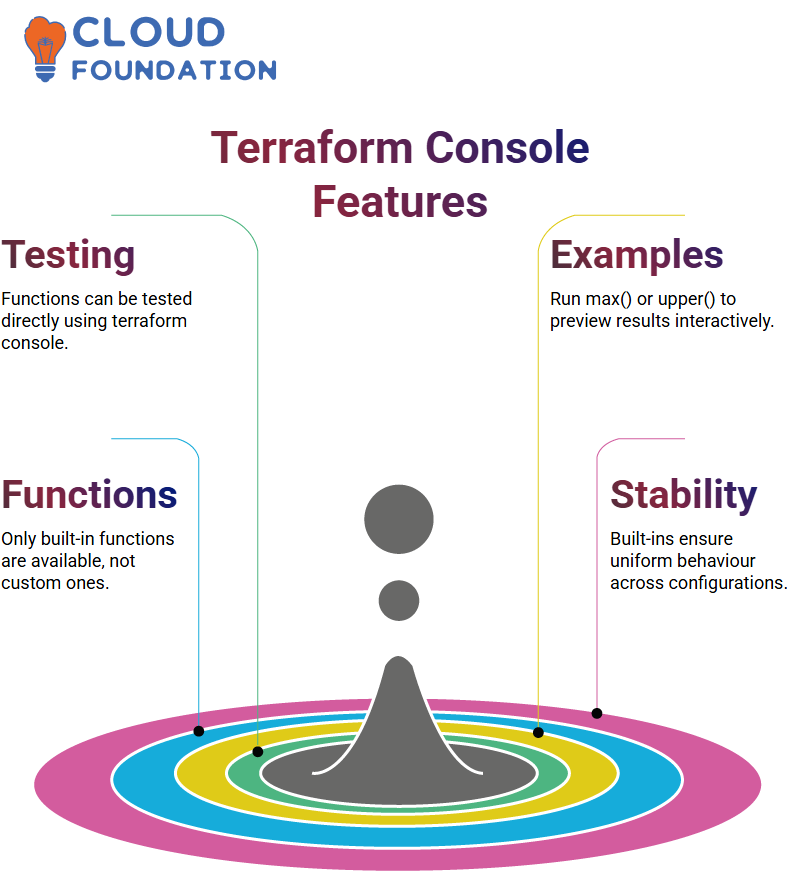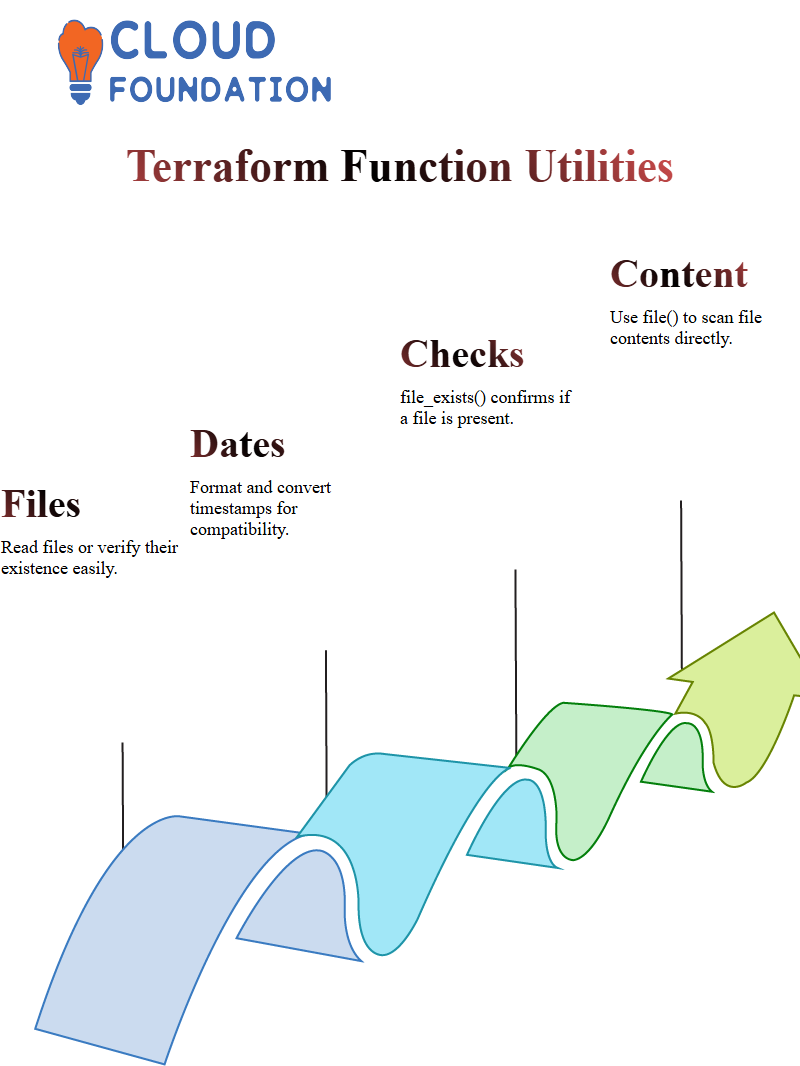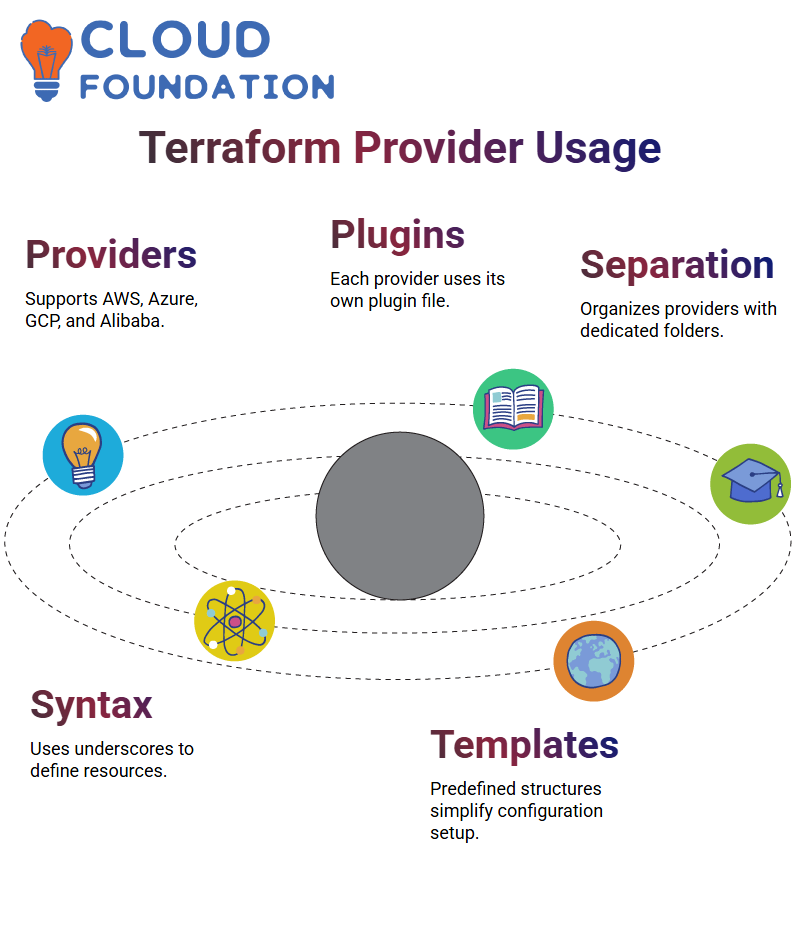Training on Terraform Functions
Understanding Terraform Functions
Terraform functions – an essential aspect of working efficiently with Terraform.
If you have experience working with programming languages such as C or Java, then functions will likely come up frequently when discussing how functions help reuse code and streamline configurations.
Terraform functions serve the same function. Instead of writing repetitive code, we utilise built-in functions provided to streamline configurations.

However, unlike Python or Java, which support user-defined functions, Terraform relies solely on built-in functions provided for efficient configurations.
How Functions Work in Terraform
Terraform functions follow an easy syntax. First, specifying their names before listing parentheses that contain arguments (some functions require one argument while others may need multiple).
Terraform provides functions to determine the number of elements present in a list; write “length(list_name)”, and Terraform returns an accurate count.
Max/Min are other useful functions that help find the maximum and minimum values, respectively, from a set.
Built-in Functions in Terraform
Terraform provides an extensive library of built-in functions, spanning numeric, string, and collection operations. These built-in options cannot be customised like user-defined functions; therefore, Terraform relies heavily on them.
Numeric functions in Terraform configurations, such as the max, min, abs, ceil and floor functions, help perform mathematical operations directly within Terraform itself.
String functions provide text manipulation capabilities, such as lower(), upper(), trim(), and join(), which help format and modify strings efficiently.
Collection functions provide essential assistance for managing lists and maps. Such functions as “length”, “merge”, and “lookup” make working with structured data easier than ever.
String Functions in Terraform
Terraform offers several string functions to manipulate text values. The lower function converts lowercase to uppercase, while upper allows users to reverse this operation.
Trim is used to eliminate unnecessary characters in strings; for example, trim(“###hello###”, “#”) results in just “Hello.” Meanwhile, join helps concatenate multiple strings together into one value.
Terraform Console
Terraform makes testing functions directly in the console easy: type “terraform console” in your terminal to experiment with different functions.
Example 1: Running “max(10, 20, 30)” will instantaneously yield “30”. Test 2: upper(“terraform”) will convert text to the string TERRAFORM”.

These interactive methods help users gain insight into the function behaviour before implementing it within configurations.
Terraform Relies on Built-in Functions
Terraform differs from conventional programming languages in that it does not support user-defined functions; instead, an extensive set of built-in functions is provided to perform various operations.
This approach ensures consistency and reliability across Terraform configurations. Since all functions have been predefined, users can focus on writing efficient infrastructure code without being distracted by function definitions.
Terraform Documentation for Functions
Terraform’s official documentation provides an overview of all available functions, along with in-depth explanations, making it essential to reference when using one of them.
Before using any function, check its documentation to understand its syntax and usage fully.
Categories such as numeric, string, and collection functions offer insight into Terraform’s capabilities.

From calculating values to formatting text and managing lists, Terraform functions streamline these processes.
Manipulating Strings in Terraform
One of the most valuable functions in Terraform is lower(), which ensures that all data provided to it by users is converted to lowercase for easier comparisons.
Upper() goes one step further by changing everything back into uppercase – as developers, we must make data handling safer and predictable for our users.
Lookup in Terraform
Terraform provides the lookup() function, which retrieves values based on keys. If no such key can be found, we can set an alternative value as an expected default to prevent unexpected errors from arising.
Zip Map in Terraform
Terraform’s Zip Map function makes associating keys and values faster and simpler, such as when storing multiple IAM user attributes together; Terraform makes mapping them seamless.
Zip Map offers a streamlined approach for storing user ARNs with unique IDs in a structured and accessible format.
Do you ever need to merge two lists into one easily and seamlessly? Terraform provides the zipmap() function as the solution! It pairs corresponding elements from two lists into a map for seamless data transformation.
Mapping Resources with Terraform Zip Map
Terraform’s zip map function facilitates seamless mapping between two separate attribute lists. Attributes may then be combined for efficient resource allocation.
Terraform makes managing instances with matching values simpler through zip mapping, providing improved readability and streamlining resource configuration across deployments.
Decoding Data in Terraform
Terraform provides multiple encoding and decoding functions.
You can efficiently decode CSV files using csvdecode(), JSON data using jsondecode(), or even URLs or YAML formats using these functions, making file processing significantly more efficient.
Files in Terraform
Terraform’s file system functions allow us to read files, check their existence and retrieve directory names easily and effortlessly.
Functions like file() will enable us to easily scan content, while file_exists() helps verify whether a file exists or not.
Date and Time Functions in Terraform
Terraform provides functions to manage dates and timestamps in various formats, ensuring compatibility across different scenarios.

Format timestamps as you see fit while also converting them to various other forms for use across your projects.
Cryptographic Functions in Terraform
Terraform offers security hashing functions, such as sha256(), sha512(), and md5(), that protect sensitive data. These safeguards provide an additional layer of security.
Terraform and Secure Data Storage
Terraform makes it simple and secure to store passwords with its hashing techniques, such as SHA-512 hashing algorithms.
By protecting against unauthorised access to data, storing passwords cannot be compromised, as anyone who gains entry cannot retrieve the original values. Only the original password can be retrieved from within Terraform itself.
Terraform ensures that none of its backend systems store user credentials directly; all sensitive data is handled safely to reduce risks.
Scaling User Management in Terraform
Handling multiple users in Terraform is straightforward, thanks to its count-based loops.

Simply specifying the number of users using count variables is all that’s needed to provide efficient resource provisioning, whether forming a group of five users at once or scaling infrastructure automatically.
Terraform’s Splat Expression
Terraform’s Splat Expression provides a convenient way to access the resource attributes of multiple instances efficiently.
Working with cases often requires retrieving specific values without writing redundant code, and using Splat can simplify and accelerate this task.
Terraform simplifies data retrieval by automatically retrieving instance data using splat expressions, providing seamless access to resources when handling multiple resources with proper count values as part of its seamless access model.
Errors in Terraform
Errors in Terraform often result from incorrect resource attributes being set.
Waiting for one of your instances to go haywire can be particularly annoying; understanding Terraform’s error handling mechanisms makes debugging much simpler.
Terraform optimises resource management by appropriately indexing count-based attributes to ensure smooth mapping of identifiers.
Acknowledging its significance for optimisation purposes is paramount.
Terraform Resource Mapping
Mapping resources effectively in Terraform helps prevent errors and ensure efficient infrastructure automation.
Understanding attribute indexing, counting values, and zip map functionalities facilitates quick deployments.
By following these best practices, Terraform users can safely manage resources and enhance infrastructure configuration without additional complications.
Understanding Terraform Providers
Let’s discuss Terraform and how it handles providers. When working across multiple cloud platforms, such as AWS, Azure, Alibaba, or GCP, you may wonder how Terraform organises them.
The answer lies within: Terraform stores all providers in its folder called “Terraform Providers,” each with its dedicated section for easy management and clear separation between providers.
Terraform relies heavily on plugins for optimal operation, and each provider is represented by an application file within Terraform’s provider directory.
 No matter whether your infrastructure of choice is AWS, Azure, Alibaba or elsewhere, Terraform ensures it all stays organised to optimise management efficiency.
No matter whether your infrastructure of choice is AWS, Azure, Alibaba or elsewhere, Terraform ensures it all stays organised to optimise management efficiency.
Defining Resource Blocks in Terraform
Let’s create our first resource block with Terraform. First, we must specify our provider name, followed by the resource type, separated by an underscore character.
For an Amazon Web Services (AWS) instance, this would be represented as: ‘AWS_Instance’. For VPC creation, it would read as: ‘AWS_VPC’. Terraform makes these definitions easy and understandable.
Terraform documentation simplifies the creation of each cloud resource by providing predefined syntax for each resource.
Search AWS instance definitions to copy their attributes directly and use them within your Terraform configuration file.
Resources in Terraform
Once your Terraform resource has been defined, the next step is to configure it. Every Terraform resource block requires specific attributes, such as Amazon Machine Images (AMIs) or instance types.
With Terraform, you can fetch these directly from AWS for use within your resource block.
Terraform supports additional configurations, such as tags, to help efficiently identify resources.

Although not mandatory, adding tags is considered best practice to allow better resource management within Terraform.
Terraform Destroy to Manage Costs
Effective resource management is crucial when managing cloud billing. A neglected instance may incur unnecessary charges; to remove them quickly, use the’ terraform destroy’ command.
The destroy command makes sure a resource has been removed from AWS, eliminating additional billing.
Just like with apply, Terraform prompts for confirmation before initiating its destruction process if ‘yes’ is chosen; then shortly afterwards, it’s over, and your resource is gone, serving as evidence that everything went according to plan.
Scaling Terraform for Multiple Resources
As Terraform evolves, managing multiple resources becomes a thrilling challenge.
Regardless of whether we deploy five, ten, or even more instances simultaneously, scaling has never been simpler with Terraform.
Do you need to delete specific resources while keeping others intact? Terraform offers selective removal capabilities and helps optimise resource allocation by following structured plans to ensure only necessary modifications take place without disturbing our environment.

Vinitha Indhukuri
Author



